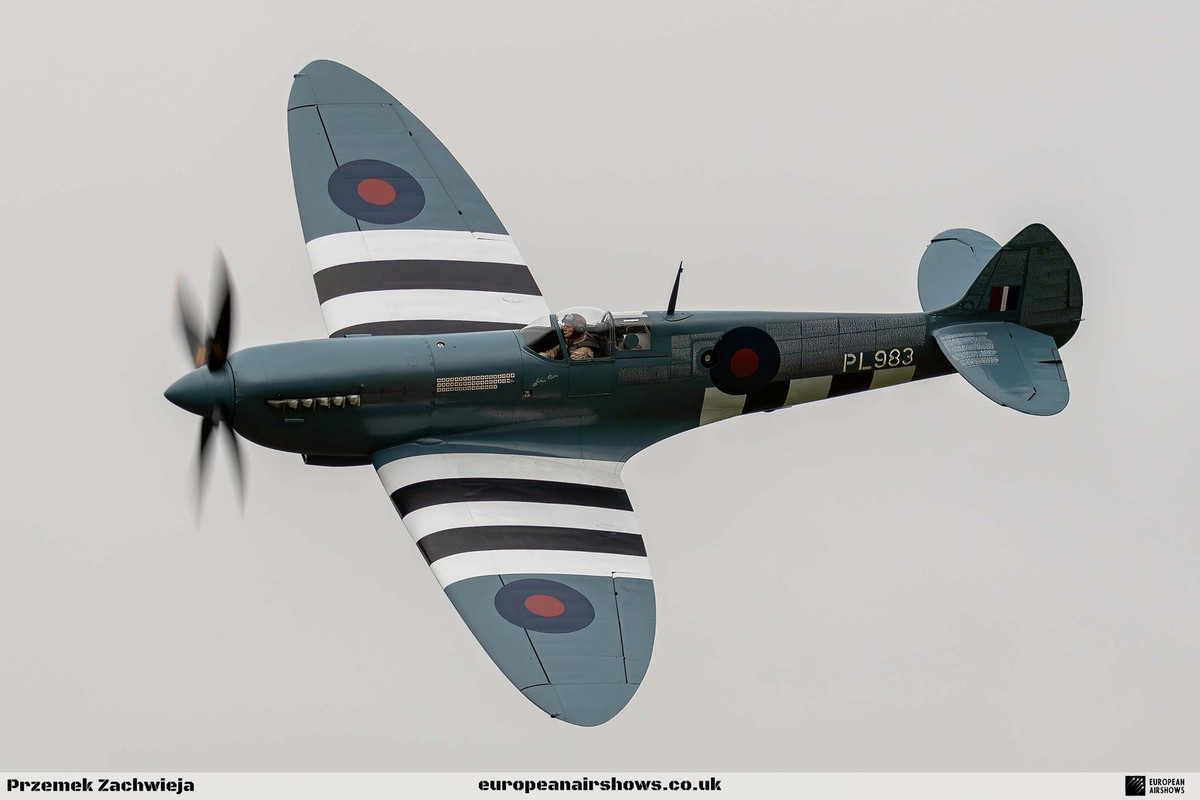
Supermarine Spitfire PR.XI G-PRXI
About the Spitfire
The Supermarine Spitfire first took to the air in the mid‑1930s and quickly became an icon of British aviation. Designed by Reginald Mitchell for the Royal Air Force, its distinctive elliptical wing and innovative stressed‑skin construction enabled exceptional speed and maneuverability. From early prototypes to successive “marks” that introduced improved armament, stronger structures, and more powerful Rolls‑Royce Merlin engines (and later Griffon engines), the Spitfire was continuously refined to meet the changing demands of aerial combat during World War II. Its elegant design and high performance made it a symbol of determination and hope during Britain’s darkest hours.
Throughout its operational history, the Spitfire evolved from a sleek, single‑seat interceptor into a multifaceted workhorse. Early versions faced significant production challenges with rapid modifications—ranging from upgrades in cockpit design to re‑armament changes driven by combat experience. The aircraft played a decisive role in the Battle of Britain and later proved adaptable as a fighter‑bomber, a high‑altitude interceptor, and even as a carrier‑based fighter (in the Seafire variant). By the end of the war, more than 20,000 Spitfires of various marks had been built, a testament to its versatility and the industry-wide efforts that supported its production.
Even as World War II drew to a close, the Spitfire’s development continued with further modifications to improve high‑altitude performance, extend range with increased fuel capacity, and enhance pilot visibility. The transition from Merlin to Griffon engines ushered in a new era of performance that allowed the aircraft to remain competitive against evolving enemy designs. Long celebrated after the war as a masterpiece of aeronautical engineering, the Spitfire is now an enduring symbol of British ingenuity, frequently appearing in museums and airshows, where it continues to captivate aviation enthusiasts around the world.
Specifications
Crew
1
Length
29 ft 8 in (9.1 m)
Wingspan
36 ft 8 in (11.23 m)
Height
12 ft 6 in (3.85 m)
Max Speed
416 mph (671 km/h, 362 kn)
Range
845 mi (1,360 km, 734 nmi)
Service Ceiling
40,000 ft (12,200 m)
Rate of climb
3,860 ft/min (19 m/s)
PR Mk XI Variant
The need for precise intelligence gathering during wartime led to the development of photo‑reconnaissance (PR) variants of the Spitfire, culminating in models like the PR Mk XI. Drawing on lessons learned from earlier reconnaissance adaptations—including modifications made to variants such as the PR Mk X—the PR Mk XI was designed to capture high‑quality aerial imagery while retaining the core performance and agility of its fighter counterparts. Its design incorporated dedicated camera installations in the fuselage, often arranged with vertically oriented F52 cameras with long‑focal‑length lenses to ensure extremely detailed photographs at high altitude.
In designing the PR Mk XI, engineers made significant alterations to the airframe; the variant featured a modified, deeper nose fairing that accommodated a larger oil tank and additional reconnaissance equipment without adversely affecting the aircraft’s balance. Standard fighter armament was removed in favor of camera installations and specialized, unarmoured wrap‑around cockpit glazing that minimized visual obstructions and optical distortions. Such modifications allowed pilots to have an enhanced view below and to the side while operating at high altitudes, playing a crucial role in gathering actionable intelligence on enemy installations and troop movements.
The operational impact of the PR Mk XI was significant, as its improved camera systems and extended range provided detailed photographic reconnaissance that shaped mission planning and strategic targeting. This variant demonstrated that the inherent high‑performance characteristics of the Spitfire could be successfully adapted to meet specialized duties beyond the traditional fighter role. As a result, the PR Mk XI emerged as an indispensable tool in both tactical reconnaissance operations during the war and in postwar survey missions, underscoring the adaptability and enduring legacy of the Spitfire design.
Did You Know?
- The destruction of Supermarine’s Itchen and Woolston factories by enemy bombing led to production being shifted to numerous “shadow factories”—with Castle Bromwich becoming the main hub for Spitfire manufacturing.
- Early Spitfires were famous for their elegant, elliptical wing design, chosen not only for its low induced drag but also for its aesthetic appeal—a design feature that helped to capture the public’s imagination.
- The Spitfire Mk IX was actually developed as a “stopgap” measure in response to the Focke‐Wulf Fw 190 threat and was produced from converted Mk Vc airframes before later high‐altitude models appeared.
- Some Spitfire variants were adapted for photo reconnaissance. For example, the PR Mk XIX became the definitive reconnaissance version with increased fuel capacity and specialized camera installations.
- Engine changes sometimes required more than simply swapping powerplants—the installation of the Griffon engine, for instance, necessitated modifications to the cowling, tail, and undercarriage to cope with its different thrust line and increased weight.
Test Your Knowledge
1. Which factory became the main production site for Spitfires after the original Itchen and Woolston plants were destroyed?
Spitfire PR.XI G-PRXI
Spitfire PR.XI PL983 (G-PRXI) is one of only two airworthy survivors of its variant—a model specially designed for high-altitude, long-distance photographic reconnaissance. Developed to undertake high-stakes missions, including capturing the first images that revealed the extent of the breaches following the Dambusters raid, the aircraft had its armament removed and extra fuel tanks installed to greatly extend its range. This configuration left the PR.XI with only its operational ceiling and speed as defensive measures, while pilots had to endure the harsh realities of flying in an unpressurised cockpit at extreme altitudes.
PL983 first flew in October 1944 and entered active service in 1945, operating with 4 Squadron on photographic missions over Europe. After the end of hostilities, the aircraft was transferred to 2 Squadron in Germany, continuing its role in reconnaissance during the post-war period. The design of the PR.XI, emphasizing photographic capabilities over combat, allowed it to play a crucial role in verifying the damage inflicted during key wartime operations, even as it required pilots to cope with the extreme conditions encountered at high altitude.
Following the gradual replacement of Spitfires by jet aircraft in the RAF, many of these iconic planes were scrapped. However, PL983 avoided this fate when it was gifted to American Air Attaché Livingstone Satterthwaite for his personal transport. During this period, the aircraft retained its distinctive “PR Blue” colour scheme, though its military markings were removed and its roundels overpainted to reflect its new civil registration. Notably, celebrated ATA pilot Lettice Curtis flew PL983 in civilian air races, and in 1948 she set a National 100 km close-circuit record at an average speed of 313.07 mph during the Lympne International Air Races.
In the early 1950s, the aircraft was returned to the Vickers Armstrong factory and then donated to the Shuttleworth Collection at Old Warden, Bedfordshire, where it remained on static display for around 25 years. It was later moved to Duxford for restoration to flying condition and was eventually sold at auction to French collector and pilot Roland Frassinet. Rebuilt by Trent Aero at East Midlands Airport, the Spitfire resumed flight in 1984. Three years later, it was acquired by warbird collector Doug Arnold, who saw the aircraft featured in the television series Piece of Cake as it depicted an early-mark Spitfire operating in France during the early stages of World War II. Following Arnold’s death in 1992, PL983 entered storage until re-emerging in 1999 under the ownership of Justin Fleming.
The Aircraft Restoration Company eventually took possession of PL983 and commissioned a full rebuild that restored the original PR.XI “wrap-around” Perspex windscreen and reinstalled its factory-original Rolls-Royce Merlin 70 engine. Returning to the skies in 2018 and adorned in authentic “PR Blue” livery, the aircraft also displayed a white-painted tribute to Lettice Curtis, linking it further to its storied past. During the restoration, the crew affectionately nicknamed the aircraft “Eleven,” later shortened to “L” in homage to both its designation and Curtis herself. In 2020, as the aircraft neared the end of a maintenance cycle, a test flight coincided with the UK-wide “Clap for Carers” initiative during the COVID-19 pandemic. Flown by John Romain, the Spitfire, then dubbed the “NHS Spitfire,” carried the inscription “THANK U NHS” and was adorned with the names of NHS heroes, ultimately raising over £130,000 for NHS Charities Together. The aircraft later spread its message of gratitude across 255 hospitals throughout the United Kingdom before receiving temporary D-Day stripes in 2024 to commemorate the 80th anniversary of D-Day.














